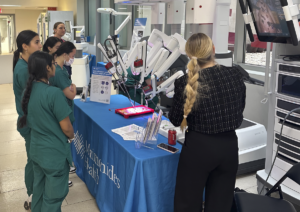Summary
Breathing isn’t something most people think about but, for some, it doesn’t come naturally. Knowing your child has asthma is the first step to dealing with it. Dr. Michael Marcus discusses what to look out for and what to do about it.
Listen on Spotify Listen on Apple Podcasts Listen on Google Podcasts
Transcript
Joey Wahler (Host): Asthma is a condition that adversely affects breathing, so we’re discussing pediatric asthma and how it’s treated. This is Maimo Med Talk. Thanks for listening. I’m Joey Wahler.
Our guest from Maimonides is Dr. Michael Marcus, Director of Pediatric Pulmonary Medicine and Allergy Immunology and Vice Chair of the Pediatric Ambulatory Network. Dr. Marcus, thanks for joining us.
Dr Michael Marcus: You’re very welcome. It’s a pleasure.
Joey Wahler (Host): Same here. So in a nutshell, first, what exactly is asthma? What’s going on?
Dr Michael Marcus: So asthma is a condition where the body has an abnormal reaction to some substance. The reaction in asthma is focused in the lungs where three things occur. First, there’s an inflammatory response within the lungs, which leads to spasm of the airways, swelling of the airways and a buildup of mucus. The combination of those three things leads to narrowing of the airway, making it much more difficult to breathe.
Joey Wahler (Host): And so why do some people have it and others.
Dr Michael Marcus: It’s a very good question and we wish we knew the answer. Certainly, there’s a genetic component to asthma where if one or both parents have asthma, there’s a significantly greater risk for the child to develop asthma. There’s also an environmental component, where if a child is brought up from a very early age in environment of high pollution, such as if there’s cigarette smoke in the household, there’s a greater chance for the child to develop asthma as well. And finally, there are some infection links. Certain viruses will lead to children to have recurrent episodes of wheezing at a young age, which is a form of asthma, although many children with that form of asthma can outgrow their symptoms over time.
Joey Wahler (Host): So what are the common symptoms for pediatric asthma?
Dr Michael Marcus: The first symptom that sometimes goes unrecognized is a chronic cough. Many times the cough comes before the true breathing difficulty and the characteristic wheezing that we think about with asthma. The cough may not get better with common cough approaches. It will linger for more than 10 days and clearly needs to be reevaluated by a qualified physician. Beyond that, the common symptoms that we know and frequently associate with asthma are the breathing difficulty where a child will breathe very rapidly, where they’ll get fatigued with exercise much more quickly than what you would based on their age and the activity being performed. And finally, they develop wheezing, which is a high-pitched, whistling-type sound mostly when children are breathing out rather than breathing in, that’s the sign that there’s the most severe form of blockage in the airways of the lungs.
Joey Wahler (Host): Gotcha. So at what age does asthma usually start in kids?
Dr Michael Marcus: It’s a tricky question. We can see the symptoms of asthma as young as six months of age, and sometimes even younger. Many times, those children have the cough or the wheeze as the result of viral infections. But occasionally, allergies can occur even at that young age. The tricky part is that it’s difficult to diagnose asthma at such a young age, because many viruses cause children to wheeze once and then they never whe again. That’s not a child with asthma. And so when you have a child at a very young age, like six months, who’s having their second or third episode of wheezing or their wheezing isn’t getting better within 10 days to two weeks, that’s the time time we start thinking that this may be a case of asthma. We then take a look at that family component because, if one or both parents have asthma, then it’s much more likely that this wheezing episode is the early signs of asthma.
Joey Wahler (Host): So how common is pediatric asthma? And is it any more or less prevalent than in years past?
Dr Michael Marcus: It depends on the definition you use. The numbers say that probably about 10% of children will have some form of repeated episodes of wheezing and could be diagnosed as asthma. If you have a family history of asthma, there’s about a 30% chance that you’re going to develop asthma, as opposed to just the general population where that number’s about 10%.
Joey Wahler (Host): Any particular groups that asthma seems to affect most in kids?
Dr Michael Marcus: It really crosses the spectrum. I think looking at that family background and seeing other signs of asthma or asthma-like conditions such as eczema or hay fever and allergic rhinitis will help us identify the patient who’s at the greatest risk of asthma. But any child from any group can certainly develop asthma. Having symptoms of asthma, however, is clearly more common in families that live in more difficult living conditions. If they have roaches, if they have mice, if there’s cigarette smoke floating around, if there’s mold on the walls, these are things that cause the symptoms of asthma to be much more common and for the asthma to become more severe.
Joey Wahler (Host): Why roaches and mice, why would that have an impact?
Dr Michael Marcus: It’s interesting, but roaches and mice both produce a potent protein that can trigger the same type of inflammatory reaction that leads to the symptoms of asthma. And so early and high concentration of exposure to those things will give a child greater symptoms of their asthma conditions.
Joey Wahler (Host): Interesting. How about weather conditions, doctor? What impact might living in a warmer climate have on an asthmatic patient?
Dr Michael Marcus: It’s a common question that I get and weather conditions by themselves really don’t affect asthma other than cold, dry air being a significant trigger for wheezing in patients with asthma. The thing about weather conditions and the thing about moving to different climates is much more related to the things that grow. And so, if you’re in the northeast, you have a certain type of pollen from the grass and the trees and the weeds that are common. If you move to someplace like Arizona, which is more hot and dry, the foliage and pollen in that area is very different. And so, if you hadn’t been exposed to that yet, you won’t have allergies to those things yet. But if you continue in those environments for a long period of time, eventually you develop allergies to those things and eventually the asthma symptoms return.
Joey Wahler (Host): Aha. So actually it’s not necessarily warmer climate as much as colder, dryer climate, which most people probably would not think is the case. Okay. So how about treating pediatric asthma. What are the common treatments?
Dr Michael Marcus: There are two approaches that are important to take. One is to identify the triggers as best as possible. I do allergy testing, monitor the patient’s response in different environments and to different foods, so that if we can identify the triggers for their asthma and are able to avoid those triggers, we can decrease the risk of symptoms being set off. If a child is allergic to cats, for example, you certainly would rather not have a cat in the house and you definitely do want the cat in the child’s room ever. That’s just one example.
Secondly, if a child has asthma, identify how severe the problem is with the help of a physician, and then decide whether the child can use medicine on an as needed basis, triggering only the symptoms of the disease or whether they’ve crossed that threshold of severity and they need daily prevention therapy.
The key here is that if we use daily prevention therapy properly, then we decrease the risk that the asthma will become more severe with age and give children the best opportunity to have the healthiest life. If we delay using the prevention therapy and continue to treat asthma on an as needed basis, treating only the symptoms, then we miss the opportunity of preventing progressive damage and limiting the severity of asthma over time.
Joey Wahler (Host): Any difference between treating kids and adults for asthma?
Dr Michael Marcus: Only that children are a bit less cooperative sometimes. They’re not always able to take the inhaled medications with the right technique and they need that supervision and guidance. The flip side though is that since parents really do control children’s lives and we tend to care for our children better than we care for ourselves, children are more likely to use their medication properly once the parent understands the need for the medication.
With inhaled medications, we have different types of devices that can assist the child to use the medication in the best fashion, which will allow the medicine to reach the lungs to the best effect. And so using these assistant devices is an important piece that we add to a child’s therapy where it’s not always necessary in an adult’s therapy.
Joey Wahler (Host): Let’s backtrack for a moment, doc. As a specialist in pediatric pulmonary medicine, what would you say drew you to that area of expertise in the first place?
Dr Michael Marcus: The very first child I took care of with asthma really grabbed my heart because their life was so affected by their disease. They couldn’t go out and play with their friends without being affected and having to sit on the sidelines. They were losing the ability to socialize. They missed days at school. And the parent couldn’t even go to work because they were worried about what was going to happen. And that child really grabbed my heart. When we started taking care of that child, when we helped the parent understand the way to prevent symptoms using the prevention medicine, it changed the child’s life. The child became active, had friends and the parent was able to actually go back to work and feel that she was productive in her family and her child was still safe. That success just grabbed me and it became what was always in my mind as the type of approach, the type of family and the type of result that I wanted to see with my patients.
Joey Wahler (Host): Wow, what a great story and makes me wonder in closing here, when you’re able to impact lives like that, and I’m sure you’ve done so many times over since, how rewarding is that for you?
Dr Michael Marcus: It’s what it’s all about. It’s why I became a physician. It’s what makes the work, the tediousness of writing notes, the headaches of management, it makes it all go away because ultimately that’s what we’re in this for, to help save lives.
Joey Wahler (Host): Absolutely. Great to hear. Thanks again for the story. And of course, for all the other information. Folks, we trust your now more familiar with asthma in children. Dr. Michael Marcus, thanks so much again.
Dr Michael Marcus: You’re very welcome. It’s been a pleasure.
Joey Wahler (Host): Same here. Now, to make an appointment, please call 718-283-7500. Again, 718-283-7500. For more information, please visit maimo.org. Again, that’s M-A-I-M-O.org. If you found this podcast helpful, please share it on your social media. And thanks again for listening to Maimo Med Talk. Hoping your health is good health, I’m Joey Wahler.







